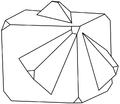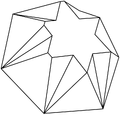Loparite-(Ce)
Loparite-(Ce) is a granular, brittle oxide mineral of the perovskite class. It is black to dark grey and may appear grey to white in reflected light on polished thin section with reddish brown internal reflections.[4] It has the chemical formula of (Ce,Na,Ca)(Ti,Nb)O3.[3] Nioboloparite is a variation of Loparite-(Ce) containing niobium.[5]
| Loparite-(Ce) | |
|---|---|
-41714.jpg) | |
| General | |
| Category | Oxide minerals |
| Formula (repeating unit) | (Ce,Na,Ca)(Ti,Nb)O3 |
| Strunz classification | 4.CC.35 |
| Crystal system | Loparit-(Ce)-Q: tetragonal[1] Loparit-(Ce)-O: orthorhombisch[1] Loparit-(Ce)-C: cubic[2] |
| Identification | |
| Color | Black to grey-brown in thin section |
| Crystal habit | Cubic and octahedral crystals and massive |
| Twinning | Penetration twins common on [111] |
| Cleavage | [100] Imperfect |
| Fracture | uneven |
| Tenacity | Brittle |
| Mohs scale hardness | 5.5 - 6.0 |
| Luster | Metallic to sub-metallic |
| Streak | reddish brown |
| Diaphaneity | opaque, transparent in thin fragments |
| Specific gravity | 4.60-4.89 |
| Optical properties | Isotropic, anomalously anisotropic |
| Refractive index | n = 2.26–2.38 |
| References | [3] |
Loparite occurs as a primary phase in nepheline syenite intrusions and pegmatites. It is also found replacing perovskite in carbonatites.[3]
Loparite was first described for an occurrence in the Khibiny and Lovozero massifs, Kola peninsula and northern Russia.
- Crystal structures of loparite



Etymology
The term originates from the word Lopar, the Russian name for the Sami indigenous inhabitants of the Kola peninsula, and the cerium content.[3][4][5]
Notes
- Mitchell R H, Burns P C, Chakhmouradian A R (2000) The crystal structures of loparite-(Ce), The Canadian Mineralogist 38, 145-152.
- Zubkova, N. V., Arakcheeva, A. V., Pushcharovskii, D. Y., Semenov, E. I., & Atencio, D. (2000). Crystal structure of loparite. Crystallography Reports, 45(2), 210-214.
- "Loparite-(Ce)" (PDF). Mineral Handbook. Mineral Data Publishing. 2005. Retrieved 2008-07-19.
- Loparite-(Ce) on Webmineral
- Loparite-(Ce) on Mindat.org
gollark: You could quite probably find programming servers unassociated with the esolangs-adjacent community.
gollark: We can give you a dedicated quarantine channel.
gollark: Many people here are the alts I use to spy on esolangs.
gollark: Yes, we have significant overlap with esolangs.
gollark: This is only 27% a programming server.
This article is issued from Wikipedia. The text is licensed under Creative Commons - Attribution - Sharealike. Additional terms may apply for the media files.